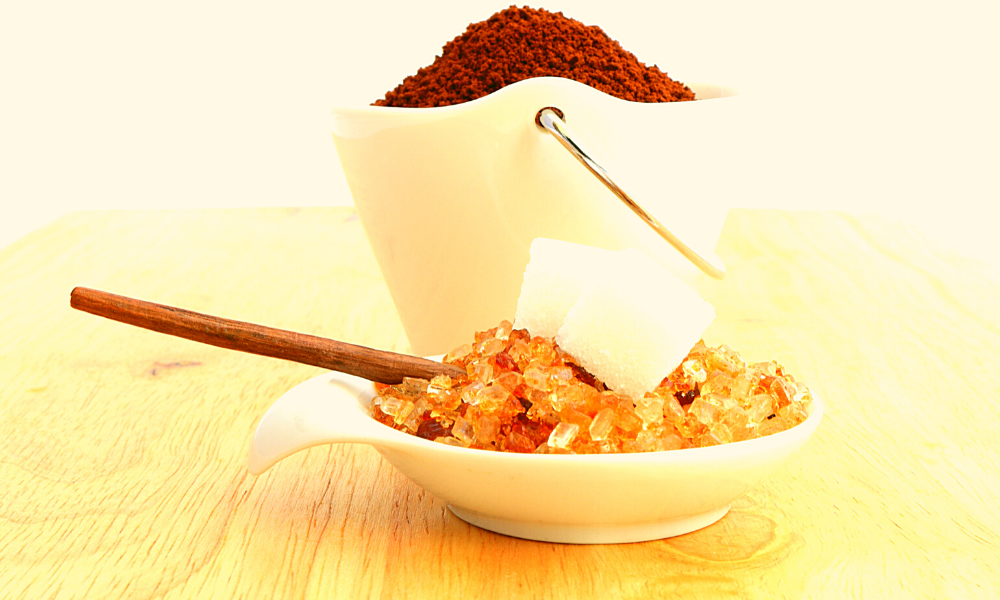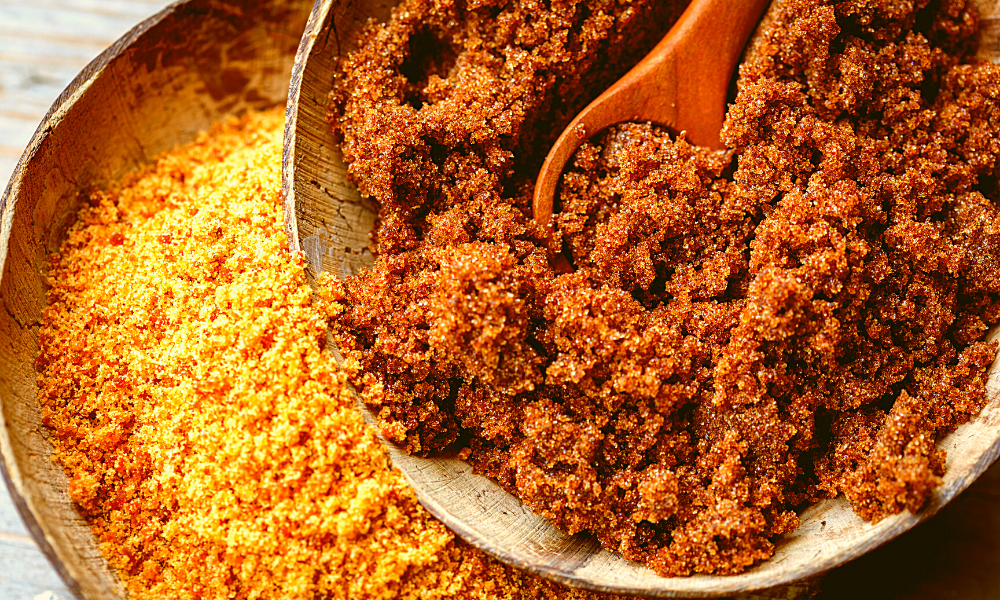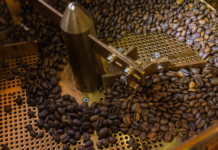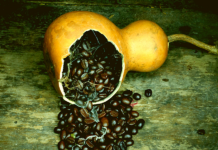Contents
- 1 Why Add Sugar To Coffee In The First Place?
- 2 Brown Sugar: What Is It?
- 3 Brown Sugar Types
- 4 Brown vs. White: the battle of the sugars
- 5 So, Can You Put Brown Sugar In Coffee?
- 6 How Does Coffee Taste With Brown Sugar Taste?
- 7 Will I Use Less Brown Sugar Than White Sugar In My Coffee?
- 8 Should You Try Brown Sugar in Coffee?
Brown sugar in coffee appears to be better, more natural, and more nutritious than white sugar.
While most coffee lovers love and strictly prefer to drink their coffee black, some men like to enjoy their coffee with sugar in order to offset its bitter taste.
One of the most preferred coffee sweetener is brown sugar. So, this begs the question: How’s brown sugar in coffee?
And is it healthier than the traditional white sugar?
This article will show you the answer as well as present you with some healthier alternatives with the goal to provide you more options on how to sweeten your daily dose of coffee.
But first…
Read More:
- Best Lipton Iced Teas
- Best Decaf Coffee: All You Need to Know About Decaf Coffee
- 10 Best Low Acid Coffee Brands Review
- Ninja Hot and Cold Brewed System Review
- Best Brazilian Coffee
Why Add Sugar To Coffee In The First Place?
There are actually many reasons as to why. However, it is a mixture of the following pieces of history and culture.
Once upon a time, sugar was actually a status symbol of the wealthy, who used it at any opportunity instead of as a staple commodity as it has become today. You see, the more people use this sweetener, the more its production grew.
And as its production increases, the cheaper sugar became. Thus, it became more common and people found more uses for it.
Once it became common and accessible to the lower class, sugar evolves into becoming a good provider of calories during a time when food production was not enough to provide for everyone. Read Here: Best Espresso Machines Under $500
So, why do you have to add sugar in your coffee? Well, coffee is better. Sugar, on the other hand, is sweet. So, when you add sugar to your coffee, you can drink it more pleasantly and quickly thanks to its sweetness.
Factory owners offered sweetened coffee and tea to their workers in order to give them a short break. The calories from the sugar and the energy from the caffeine provide worker an energy boost to continue working.
This helps both drinks to become a major part of the British cultural identity. In addition, 25% of British calorie intake during the industrial revolution was from sugar, mostly from hot drinks.
Brown Sugar: What Is It?


Brown sugar actually comes from the sugar cane plant like the traditional white sugar. Both white and Brown sugar is usually refined the same way.
However, most of the Brown sugar available on the market today is just white sugar with molasses added back to the sugar after the refining process.
White sugar is made by removing the naturally occurring molasses which is a thick dark liquid. The end result will be white sugar crystals. And with the molasses removed, the end product has a lighter flavor and color.
In order to make Brown sugar, the molasses is added back in varying amounts.
Most of the time, Brown sugar is made this way in order to control the amount of molasses added and, thus, the flavor of the end product.
Brown Sugar Types
Did you know?
Brown sugar has different types based on the amount of molasses added. Molasses influence texture, please, and color.
The higher amount of molasses added the higher density and moisture, the darker and deeper the color, and the sweeter and stronger the flavor of the brown sugar.
Here are the main types of Brown sugar available in the market today.
Light Brown Sugar
the light Brown sugar contains about 3.5% molasses. Thus, it offers a soft color and a delicate taste. The light Brown sugar is a widely available variety and is most commonly used for baking.
Generally speaking, the lighter the Brown sugar is, the lighter its flavor and taste.
Dark Brown Sugar
the old fashion Dark Brown sugar has about 6.5% molasses. Thus, it is the perfect ingredient for recipes calling for intense color and taste. The dark Brown sugar variety is a more popular choice for mincemeat, gingerbread, and other sweet and strong food.
Raw Sugar
the natural and unrefined Brown sugar, also known as raw sugar call mom or large sucrose crystals with a high amount of molasses left out of the refining process and has less moisture. The raw sugar has more minerals than dark or light Brown sugar.
Brown vs. White: the battle of the sugars


sugar is a natural ingredient that has been a part of the human diet for millennia. Although there are many types available Comer white and Brown sugar are amongst the most popular varieties.
And here, we will compare white and Brown sugar in order to give you a better understanding of their differences and similarities.
Read More:
- Best Lipton Iced Teas
- Best Decaf Coffee: All You Need to Know About Decaf Coffee
- 10 Best Low Acid Coffee Brands Review
- Ninja Hot and Cold Brewed System Review
- Best Brazilian Coffee
Nutritional differences
given that Brown and white sugar came from the same crops– either from the sugar beet or sugar cane plant— they’re quite similar.
As a matter of fact, most Brown sugar is just a mixture of white sugar and molasses as mentioned before. Molasses is the one responsible for the darker color and slightly increased nutritional value of brown sugar.
The most notable difference between White and Brown sugar in terms of nutritional value is that Brown sugar has slightly higher iron, calcium, and potassium. Read Hear: Top 10 Best Espresso Coffees
With that said, The amounts of these mineral contents in Brown sugar insignificant, thus it is not a great source of any minerals or vitamins.
In addition, brown sugar also has slightly fewer calories than traditional white sugar. However, the difference is minimal.
A teaspoon of brown sugar can provide 15 calories while a teaspoon of sugar has about 16.3 calories. Other than these minor differences, brown sugar and white sugar are similar, nutritionally speaking.
The main differences are their color and taste.
Produced Differently
Sugar is usually produced in the tropical areas where sugar beet or sugarcane plants grow. Both plants undergo the same process in order to produce sugar. However, the methods use to make it into brown sugar differ.
First off, the sugary juice from the plant is extracted. It is then purified and heated to form the concentrated brown syrup which is known as molasses.
Next, the crystallized sugar is then centrifuged (a machine that spins rapidly in order to separate the sugar crystals from the molasses) in order to produce the sugar crystals.
The white sugar is then processed even further in order to remove any extra molasses and creating the smaller crystals. Then, it is run through the filtration system that is often made with crushed animal bones, or bone char, in order to form white sugar.
The refined brown sugar is just white sugar that has had the molasses added back into it. Whereas, the whole, unrefined brown sugar is subjected to less processing than the white sugar, which allows it to retain some molasses content and the natural brown color.
Uses
Brown and white sugar can be used in different ways in cooking and baking. Although, the two can sometimes be used interchangeably, doing so can affect the flavor, color, or texture of the final product.
The molasses in the brown sugar retains moisture, so using it in baked goods offer a denser and softer final product.
For instance, cookies that are made from brown sugar will be denser and moister, while cookies made from white sugar will rise to a greater extent, which allows more air into the dough and results in an airier texture.
This is why white sugar is used in various baked goods that need adequate rising including souffles, mousses, meringues, and the fluffy baked goods.
Brown sugar, on the other hand, is used for dense baked goods like rich cookies and zucchini bread. Other uses of brown sugar include rich sauces such as barbecue sauce and glazes.
Flavor Profile and Colorings
As mentioned before, the main differences between brown and white sugar are their color and taste. Swapping your white sugar for the brown variety in recipes can affect the color of the food, giving it a brown or light-caramel hue.
White and brown sugar also have very unique flavor profiles. The brown sugar offers a deep, toffee, or caramel-like flavor because of the added molasses.
Meanwhile, white sugar is sweeter, thus you ill need to use less of it in order to obtain the desired taste. Also, its neutral flavor makes it a highly versatile ingredient.
So, Can You Put Brown Sugar In Coffee?


There are some differing thoughts here.
For the hardcore coffee fans, they will argue that you should never add anything to your coffee. No sugar, no milk, and certainly no vanilla or caramel flavorings.
To these individuals, a properly brewed specialty coffee should be enjoyed for what it is. Adding anything that can mask its natural complex flavors defeats the object of drinking the high-quality specialty cup of coffee.
For this way of thinking, adding brown sugar in coffee is somehow similar to adding lemonade to a finely aged wine. However, for most people, this is a little extreme.
For starters, not everybody likes to drink the expensive and rare specialty coffee all the time. Also, not everyone can stand the bitterness of coffee.
So, if adding a little brown sugar in your coffee helps you enjoy your morning cup more, then nobody can stop you!
Read More:
- Best Lipton Iced Teas
- Best Decaf Coffee: All You Need to Know About Decaf Coffee
- 10 Best Low Acid Coffee Brands Review
- Ninja Hot and Cold Brewed System Review
- Best Brazilian Coffee
How Does Coffee Taste With Brown Sugar Taste?
Some say that the flavor profile of brown sugar complements the flavor notes of coffee. Thus, making brown sugar versatile and accessible in all your favorite caffeinated drinks.
Brown sugar in coffee creates a natural earthy taste. The flavor of the molasses from the brown sugar certainly works well with a good cup of joe.
Personally, we like the extra layer of richness that the coffee takes on from a spoonful of brown sugar, particularly the darker varieties.
Will I Use Less Brown Sugar Than White Sugar In My Coffee?
This will depend on the variety of brown sugar you use.
The richer flavor profile of the brown sugar can help adjust the flavors in your coffee, that you are essentially covering up by adding brown sugar. This is particularly true if you’re using the natural brown sugar.
Personally, I only add ½ – 1 teaspoon of brown sugar to my large mug of coffee. But, again, this will depend on your taste and preference.
If you just want to slightly mask the bitterness and strong flavor of coffee, then half a teaspoon should be enough. But, if you’re one to enjoy a sweet treat early in the morning, then drop a teaspoon or two of brown sugar in your cup of joe.
Should You Try Brown Sugar in Coffee?
Yes, you should!
Trying something new is the only way in order to find out if what you have is already the best or not. Brown sugar has become a common ingredient amongst coffee lovers who like to give their wake-up beverage and extra flavor.
Now, that you know the basics of brown sugar and our opinion, it is up to you if you’re going to give it a chance or not.
Our best and final advice concerning brown sugar in coffee is simply to drink what you enjoy the most. If you prefer coffee with brown or white sugar or even no sugar at all, then that’s the best way for you to drink it.
Do not let anybody try to tell you any different! So, which do you prefer? With brown or sugarless?
Whatever your opinion is, feel free to leave us a comment! We simply love hearing from you. And if you did enjoy this article, don’t forget to share it with your friends and family!
Happy caffeinating!

















